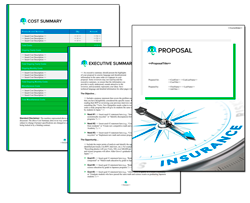
Master How to Write an Insurance Proposal: Tips for Persuasive Bids That Win Business
Are you struggling with writing an insurance proposal that catches your prospect's interest? In today's competitive market, mastering your proposal writing is vital. This article directly addresses your search on how to write insurance quotes by providing a concise, practical approach that elevates your proposal writing skills, ensuring you capture and retain your audience's attention. Anticipate learning the key components of a winning insurance proposal, all without unnecessary complexity or sales jargon.
You will also find examples of insurance proposal templates, insurance proposal graphic design themes, and filled-in sample insurance proposals in this article.
Key Takeaways
- A compelling introduction in insurance proposals should start with a personalized touch and executive summary, addressing the client's specific needs to create an initial connection.
- Customized insurance solutions require thorough research and understanding of the client's needs, industry-specific risk factors, and expectations to ensure the proposal aligns with their objectives and concerns.
- The proposal must be well-structured with a clear layout, use calls to action, showcase expertise and trustworthiness, present competitive pricing strategies transparently, and leverage visual aids and digital tools for maximized impact and streamlined processes.
- Prewritten insurance proposal templates that can be customized for more complex needs will help jumpstart your insurance proposal creation.
Creating a Winning Introduction
The first impression is often the lasting one, especially in the competitive field of insurance. A well-written introduction is your initial handshake with potential clients - it sets the tone and paves the way for the detailed information that follows.
An introduction that resonates with the client begins with a personalized cover letter and a succinct executive summary that outlines your agency's key points and the tailored purposes of your bid. By demonstrating a thorough understanding of the client's specific needs and risk assessments, you create a connection that primes them for the customized solutions your proposal will deliver.
Deciphering Client Needs for Tailored Solutions
To create a customized insurance proposal, it is crucial to fully comprehend your client's specific needs, financial circumstances, and objectives. This understanding serves as the foundation for designing a tailored solution that meets their requirements. When you fully understand the needs of your potential clients, you gather the insight needed to create a proposal that resonates with them on a personal level. This section unpacks the process of aligning your services with the client's specific needs, ensuring your pitch hits the mark.
Gathering Essential Information
Thorough research is the bedrock upon which successful proposals are built. It involves delving into the client's background, industry, existing policies, and financial landscape. This essential data provides a comprehensive view of their insurance needs, guiding you to determine the right coverage options.
The Proposal Kit's software aids in this process, allowing you to organize the gathered information into a coherent insurance proposal template, ensuring every key point is addressed and nothing slips through the cracks.
Analyzing Risk Factors

Every client brings a unique set of risk factors to the table, influenced by their industry and personal circumstances. Identifying these risks is a critical step in creating a proposal that not only provides comprehensive coverage but also anticipates potential objections.
Using Proposal Kit's software, these topics can be seamlessly integrated into your insurance proposal, ensuring a clear and compelling argument for why your services provide the necessary protection.
Aligning Services with Client Expectations
Clients seek insurance solutions that mesh with their expectations and address their concerns. By understanding these needs, you can tailor your services not only to meet but exceed their expectations, thereby cementing your role as their preferred provider.
The right insurance solutions should be designed to achieve the client's specific goals, offering peace of mind that a reliable insurance company safeguards their assets and interests. Obtaining insurance quotes is an essential step in this process.
Writing Your Insurance Proposal
Creating a comprehensive insurance proposal involves several key sections, which may or may not include:
- Cover letter and title page
- An executive or client summary
- Summary of benefits
- Coverage details, costs, and policies
- Detailed description of products and services
- A section about your business or organization
- Calls to action
Structuring Your Proposal for Maximum Impact
The structure of your insurance proposal is as critical as its content. A well-organized proposal leads the client through your argument, showcasing why your agency is the best choice.
Each section must be carefully written to ensure a coherent flow of information, making the document convincing and memorable.
Key Points to Include in Each Section
The executive summary of your insurance proposal should encapsulate the essence of your offer, setting the stage for the details that follow. Including sections that outline the insurance policies, coverage options, and the benefits of your services paints a comprehensive picture for the client. Using an insurance proposal template can help streamline this process and ensure consistency in your presentation.
It's important to provide clear details on financial commitments, like deductibles and payment terms, to ensure transparency and build trust.
Importance of a Clear Layout
A clear layout is paramount in projecting professionalism and facilitating understanding. It should not only highlight the suitability of the product offered but also reflect the agent's grasp of the client's needs. Readability and visual appeal are key elements that affect the client's perception and, consequently, their decision-making process.
The Proposal Kit software and template library are designed to automatically create structured Word format insurance proposals in a clear layout.
Calls to Action

Calls to action are sprinkled throughout your proposal to maintain client engagement and encourage a decisive response. From expressing an eagerness to partner in the cover letter to providing a clear next step on the final page, these prompts should create a sense of urgency and be personalized to the client's needs.
Incorporating digital options like online links for proposal previews and acceptance can streamline the process and keep the client's interest piqued.
Demonstrating Expertise and Trustworthiness
In an industry founded on trust, demonstrating your agency's expertise and reliability is non-negotiable. The proposal must resonate with assurance, from the executive summary to the final call to action. By weaving in success stories and a deep understanding of policy benefits, you showcase your agency's capability to provide financial security and protect the client's interests.
Sharing Company Success Stories
Building trust with potential clients begins with sharing the journey of your insurance business. The company background section should bring to life your history, team, and past successes, painting a picture of a reliable and competent organization.
Including testimonials from satisfied clients serves as powerful social proof, reinforcing your insurance company's credibility.
Highlighting Industry Knowledge
Most insurance agents must demonstrate a keen understanding of the insurance industry and an ability to stay up to date with its trends. In a changing risk ecosystem, it's your mastery of industry knowledge that will enable you to present innovative and personalized insurance solutions that meet current client expectations.
Pricing Strategies That Close Deals
Navigating the pricing landscape requires a strategy that not only appeals to the client's budget but also underscores the value of your service. A successful pricing strategy should include:
- A detailed premium summary, complete with policy costs and payment options
- Transparency and clarity in the pricing structure
- Tailoring the pricing to meet the specific needs of the client
- Offering flexibility in payment options to accommodate different budgets
By implementing these strategies, you can close deals and demonstrate the value of your service to clients.
Simplifying Technical Terms

The insurance world is replete with jargon that can easily bewilder clients. By simplifying technical terms, you make policy benefits and features more accessible, establishing your expertise and preempting doubts.
For instance, replacing indemnity' with compensation' demystifies insurance concepts, enhancing understanding and trust.
Competitive Pricing Analysis
Presenting a competitive pricing analysis within your proposal is a testament to your research and industry expertise. It's important to demonstrate that your offerings are not just competitively priced but also packed with distinctive value, helping clients make informed insurance decisions.
Enhancing Proposals with Visual Aids

A picture is worth a thousand words, particularly when explaining the complexities of insurance coverage. Using graphs, charts, and infographics can clarify coverage limits and the claim process, making your insurance proposals more engaging and easier to understand. These visual aids not only assist in simplifying concepts but also highlight your ability to communicate effectively.
Addressing Potential Objections Proactively
One hallmark of a successful proposal is its ability to anticipate and address potential objections. By considering common questions and concerns clients might have, you can incorporate answers into your proposal, demonstrating your attentiveness and industry acumen. A well-written FAQ section serves as a proactive approach to dispel doubts and cement your agency's credibility.
Using Digital Tools for Streamlined Proposals
In today's digital age, leveraging tools like Proposal Kit can revolutionize your proposal process. These tools not only save time but also ensure your proposals maintain a consistent and professional tone.
With customizable templates and a clear layout, your proposals will reflect your agency's brand and expertise efficiently.
Here are some related samples included in every downloadable Proposal Pack
The AI Writer generates a first draft of these templates - customized to your company, client, and project - in just minutes, giving you a head start on editing. Get any Proposal Pack or Proposal Kit Professional, and all of these samples, and the AI Writer are included.
Here are some related downloadable templates
The AI Writer generates a first draft of these templates - customized to your company, client, and project - in just minutes, giving you a head start on editing. Get any Proposal Pack or Proposal Kit Professional, and all of these templates and the AI Writer are included.
Personalizing the Client Experience
The personal touch can make all the difference in securing more clients. Personalized experiences, especially those that cater to significant life events, set your services apart. By integrating client testimonials and offering interactive tools, you provide a personalized journey that resonates with clients, showing empathy and a commitment to meet their needs.
Final Touches: Proofreading and Professional Presentation

The refinement of your proposal is as critical as its creation. Proofreading ensures that your document is free of mistakes, while feedback from colleagues can provide invaluable insights to polish your presentation.
Consistent design elements and an attractive cover image contribute to a professional impression that speaks volumes about your attention to detail.
Summary
In wrapping up, writing an insurance proposal is an intricate blend of understanding client needs, demonstrating expertise, and presenting information in a clear and engaging manner. Your proposal is more than a document - it's a reflection of your agency's commitment to serving clients with personalized, reliable solutions. Let it be the key that unlocks new business opportunities, building long-lasting relationships based on trust and value.
 Proposal Kit Professional provides the most content, including legal contracts and a free design theme pack. Plus, advanced software features include custom branding and customizable quoting databases.
Proposal Kit Professional provides the most content, including legal contracts and a free design theme pack. Plus, advanced software features include custom branding and customizable quoting databases. Proposal Pack for Any Business covers this type of proposal and includes samples. There are also some commonly used specialty design themes available:
Proposal Pack for Any Business covers this type of proposal and includes samples. There are also some commonly used specialty design themes available:Photo Design Proposal Packs
Line Art Design Proposal Packs
Frequently Asked Questions
What types of insurance would you write a proposal for?
- Property Insurance: Protects the physical assets of a company, such as buildings, equipment, and inventory, against damage from fire, storms, theft, and other perils.
- Liability Insurance: Offers protection against claims resulting from injuries and damage to people and/or property. It typically includes general liability, professional liability (errors and omissions), and product liability insurance.
- Workers' Compensation Insurance: Covers medical costs and a portion of lost wages for employees who become injured or ill on the job. It also provides death benefits to surviving dependents.
- Commercial Auto Insurance: Protects company-owned vehicles or personal vehicles used for business purposes. It covers liability and physical damage in the event of an accident.
- Business Interruption Insurance: Compensates for lost income and covers operating expenses when the business is unable to operate due to a covered disaster.
- Cyber Liability Insurance: Offers protection against losses resulting from cyber attacks or data breaches. It covers costs related to data recovery, legal fees, and customer notification.
- Directors and Officers Insurance: Protects the personal assets of corporate directors and officers in the event they are sued for wrongful acts while managing the company.
- Employment Practices Liability Insurance (EPLI): Covers claims from employees alleging discrimination, wrongful termination, harassment, and other employment-related issues.
- Commercial Umbrella Insurance: Provides additional coverage beyond the limits of other liability policies, offering an extra layer of protection against major claims and lawsuits.
- Key Person Insurance: Offers financial protection in the event of the death or incapacitation of a key executive or employee critical to the business.
What is the best way to secure potential customers as new clients in the insurance industry?
To secure potential customers as new clients in the insurance business, identify their needs and write a winning business proposal outlining how you can meet those needs and why you are the best choice for their insurance needs. This approach helps to establish trust and demonstrate value upfront.
What should be included in the final page of an insurance proposal template?
In conclusion, the final page of an insurance business proposal should include a clear call to action, outlining the next steps you want the client to take. This could involve signing a contract or scheduling a meeting to discuss further.



 Cart
Cart
 Are you just looking for a template, sample, or software for your insurance proposals? Click these links to skip down the page and get right to it.
Are you just looking for a template, sample, or software for your insurance proposals? Click these links to skip down the page and get right to it.








 Facebook
Facebook YouTube
YouTube Bluesky
Bluesky Search Site
Search Site